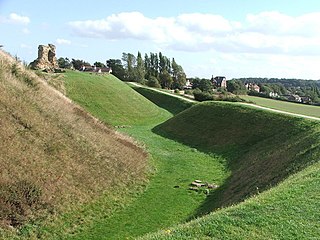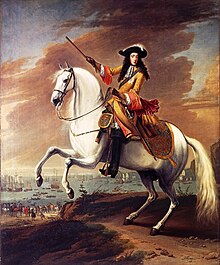
The Commonwealth was the political structure during the period from 1649 to 1660 when England and Wales, later along with Ireland and Scotland, were governed as a republic after the end of the Second English Civil War and the trial and execution of Charles I. The republic's existence was declared through "An Act declaring England to be a Commonwealth", adopted by the Rump Parliament on 19 May 1649. Power in the early Commonwealth was vested primarily in the Parliament and a Council of State. During the period, fighting continued, particularly in Ireland and Scotland, between the parliamentary forces and those opposed to them, in the Cromwellian conquest of Ireland and the Anglo-Scottish war of 1650–1652.

The English Civil War refers to a series of civil wars and political machinations between Royalists and Parliamentarians in the Kingdom of England from 1642 to 1651. Part of the wider 1639 to 1653 Wars of the Three Kingdoms, the struggle consisted of the First English Civil War and the Second English Civil War. The Anglo-Scottish War of 1650 to 1652 is sometimes referred to as the Third English Civil War.

The Protectorate, officially the Commonwealth of England, Scotland and Ireland, was the English form of government lasting from 16 December 1653 to 25 May 1659, under which the kingdoms of England, Scotland, and Ireland, with their associated territories were joined together in the Commonwealth of England, governed by a Lord Protector. It began when Barebone's Parliament was dissolved, and the Instrument of Government appointed Oliver Cromwell as Lord Protector of the Commonwealth. Cromwell died in September 1658 and was succeeded by his son Richard Cromwell.

George Monck, 1st Duke of Albemarle KG PC JP was an English soldier, who fought on both sides during the Wars of the Three Kingdoms. A prominent military figure under the Commonwealth, his support was crucial to the Restoration of Charles II in 1660, who rewarded him with the title Duke of Albemarle and other senior positions.

Major-General William Goffe, probably born between 1613 and 1618, died c. 1679/1680, was an English Parliamentarian soldier who served with the New Model Army during the Wars of the Three Kingdoms. A religious radical nicknamed “Praying William” by contemporaries, he approved the Execution of Charles I in January 1649, and later escaped prosecution as a regicide by fleeing to New England.

John Lambert was an English Parliamentarian general and politician. Widely regarded as one of the most talented soldiers of the period, he fought throughout the Wars of the Three Kingdoms, and was largely responsible for victory in the 1650 to 1651 Scottish campaign.

Sir Arthur Haselrig, 2nd Baronet was a leader of the Parliamentary opposition to Charles I and one of the Five Members whose attempted arrest sparked the 1642–1646 First English Civil War. He held various military and political posts during the 1639–1651 Wars of the Three Kingdoms but became an opponent of Oliver Cromwell during the Protectorate. In 1660, his actions inadvertently helped restore Charles II to the throne; unlike many senior Parliamentary leaders, his life was spared but he was confined to the Tower of London, where he died on 7 January 1661.

Edmund Ludlow was an English parliamentarian, best known for his involvement in the execution of Charles I, and for his Memoirs, which were published posthumously in a rewritten form and which have become a major source for historians of the Wars of the Three Kingdoms. Ludlow was elected a Member of the Long Parliament and served in the Parliamentary armies during the English Civil Wars. After the establishment of the Commonwealth in 1649 he was made second-in-command of Parliament's forces in Ireland, before breaking with Oliver Cromwell over the establishment of the Protectorate. After the Restoration Ludlow went into exile in Switzerland, where he spent much of the rest of his life. Ludlow himself spelt his name Ludlowe.

The Wars of the Three Kingdoms, sometimes known as the British Civil Wars, were a series of intertwined conflicts fought between 1639 and 1653 in the kingdoms of England, Scotland and Ireland, then separate entities united in a personal union under Charles I. They include the 1639 to 1640 Bishops' Wars, the First and Second English Civil Wars, the Irish Confederate Wars, the Cromwellian conquest of Ireland and the Anglo-Scottish War of 1650–1652. They resulted in victory for the Parliamentarian army, the execution of Charles I, the abolition of monarchy, and founding of the Commonwealth of England, a unitary state which controlled the British Isles until the Stuart Restoration in 1660.

John Jones Maesygarnedd was a Welsh military leader and politician, known as one of the regicides of King Charles I following the English Civil War. A brother-in-law of Oliver Cromwell, Jones was a Parliamentarian and an avid republican at a time when most of Wales was Royalist, and became one of 57 commissioners that signed the death warrant authorising the execution of Charles I following his trial. After the Restoration of the monarchy, Jones was one of few excluded from the general amnesty in the Indemnity and Oblivion Act, and was tried, found guilty, then hanged, drawn and quartered at Charing Cross.
Colonel Sir Richard Ingoldsby was an English officer in the New Model Army during the English Civil War and a politician who sat in the House of Commons variously between 1647 and 1685. As a Commissioner (Judge) at the trial of King Charles I, he signed the king's death warrant but was one of the few regicides to be pardoned.

Major-General Robert Overtonc. 1609 to 1678, was a member of the landed gentry from Yorkshire, who fought for Parliament during the Wars of the Three Kingdoms, and reached the rank of Major General in 1652. A committed republican and religious Independent who sympathised with the Fifth Monarchists, like others with similar views he opposed the establishment of The Protectorate, and was held in the Tower of London from 1655 to 1659.
Events from the year 1660 in England. This is the year of the Stuart Restoration.
Between 1639 and 1651 English overseas possessions were involved in the Wars of the Three Kingdoms, a series of civil wars and wars that were fought in and between England, Scotland and in Ireland.
Valentine Walton was an English politician, a member of the Parliamentarian faction in the English Civil War, and one of the regicides of King Charles I of England.
Vincent Potter (c.1614–1661) was an army officer in Parliament's army during the English Civil War and was one of the Regicides of King Charles I of England.

From 1649 to 1660, Puritans in the Commonwealth of England were allied to the state power held by the military regime, headed by Lord Protector Oliver Cromwell until he died in 1658. They broke into numerous sects, of which the Presbyterian group comprised most of the clergy, but was deficient in political power since Cromwell's sympathies were with the Independents. During this period, the term "Puritan" becomes largely moot, therefore, in British terms, though the situation in New England was very different. After the English Restoration, the Savoy Conference and Uniformity Act 1662 and Great Ejection drove most of the Puritan ministers from the Church of England, and the outlines of the Puritan movement changed over a few decades into the collections of Presbyterian and Congregational churches, operating as they could as Dissenters under changing regimes.

The Restoration of the monarchy began in 1660. The Commonwealth of England, Scotland and Ireland (1649–1660) resulted from the Wars of the Three Kingdoms but collapsed in 1659. Politicians such as General Monck tried to ensure a peaceful transition of government from the "Commonwealth" republic back to monarchy. From 1 May 1660 the English, Scottish and Irish monarchies were all restored under King Charles II. The term Restoration may apply both to the actual event by which the monarchy was restored, and to the period immediately before and after the event.

The Restoration was the return of the monarchy to Scotland in 1660 after the period of the Commonwealth, and the subsequent three decades of Scottish history until the Revolution and Convention of Estates of 1689. It was part of a wider Restoration in the British Isles that included the return of the Stuart dynasty to the thrones of England and Ireland in the person of Charles II.
The Restoration of the monarchy began in 1660 when the English, Scottish and Irish monarchies were all restored under Charles II after the republic that followed the Wars of the Three Kingdoms. The term Restoration may apply both to the actual event by which the monarchy was restored, and to the period immediately following the event.

















